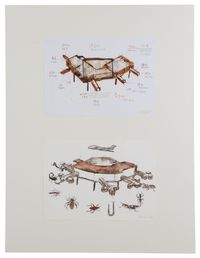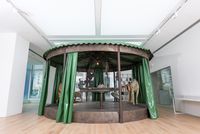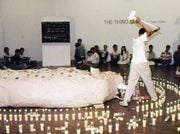In the 1980s, Huang Yong Ping was lauded as the resident provocateur of the Chinese art scene. Today, though based in Paris, he remains one of China's most well-recognised avantgarde artists. Characterised by his skepticism and persistent defiance of hegemony, Huang's monumental sculptures and installations investigate themes such as tradition, imperial history, ideology, religion, cultural conflict and ecology.
Read MoreHuang was born in 1954—an era of political upheaval in China—in the southern coastal city of Xiamen, and studied at the Zheijiang Academy of Fine Arts (now the China Academy of Art) in Hangzhou. Graduating in 1982, Huang was amongst the first students to attend the school after the Cultural Revolution. However, Huang was uncomfortable with the traditional, canonical and painting-focused teachings of the academy, and looked elsewhere for artistic insight. He was particularly roused by three distinct schools of thought: Zen Buddhism, the writings of Ludwig Wittgenstein and the avantgarde philosophies of artists such as Joseph Beuys, John Cage and Marcel Duchamp. The lattermost influence led to a distinct Dadaist turn in his early work; alongside Zha Lixiong, Liu Yiling, Jiao Yaoming and Lin Chun, Huang was co-founder of the postmodernist, avantgarde group Xiamen Dada (1983-9). With firm anti-institutional sentiments, the group is remembered for publicly burning their artworks. Asserting that the process of creating is more important than the finished product, the artists explained their actions with a manifesto that read: 'To an artist, works of art are just like opium ... without the annihilation of art works our lives will never be at peace.'
Another important example of Cage and Duchamp's influence on Huang is his early 'Roulette-Series' (1985-1988) which emphasised chance over subjectivity. One work from the series, titled Small Six Turntables (1988), is an assemblage of discs in a leather bag. The discs are inscribed with artistic qualities such as colour, composition and brushstrokes; when spun, their random alignment is meant to determine the outcome of a painting. The work's focus on fate is reminiscent of Huang's Spray Gun Painting from 1981, for which he painted with an industrial spray gun rather than a brush to relinquish control and embrace passive action. A decade later, Huang directly referenced Duchamp in his contribution to the 1997 Skultur.Projekte in Münster. Titled 100 Arms of Guan-yin and loosely based on a Buddhist figure associated with compassion, the large-scale sculpture is an enlarged metal version of Duchamp's 1914 readymade Bottle Rack, with mannequin arms holding various objects.
Beyond his indebtedness to art history, Huang also possesses a certain antipathy towards systems of knowledge. This attitude can be seen throughout many of his works, including one of his best-known: The History of Chinese Painting and the History of Modern Western Art Washed in the Washing Machine for Two Minutes (1987). As an attempt to erase the boundaries between tradition and modernity and East and West, Huang washed both books together and presented the damp contents as a pile of wet pulp on a wooden box. Similarly, for the performance A Book Washing Project, Huang washed all the books off his shelf in Xiamen and presented the resultant mush on the wall.
The distinction between East and West would become even more personal for Huang, when in 1989, at the age of 35, he travelled to Paris as one of three Chinese artists to participate in Magicians de la terre at the Centre Georges Pompidou. However, Huang's trip to Paris coincided with the Tiananmen Square massacre in Beijing, and fearing the unsettled atmosphere, he decided not to return to China. Instead, he immigrated to France, where he has lived ever since. Indeed, in 1999, Huang represented France at the Venice Biennale with a collection of cast-aluminium animals on top of the pavilion's roof.
Often portrayed in violent situations, animals have played a large role in Huang's work. His Arche 2009 (2009) comprises a 50-foot paper boat full of burnt taxidermied animals—a not-so-subtle and rather macabre reference to Noah's ark and detrimental human impact on the environment; while the morbid Leviathanation (2011) consists of a giant fibreglass fish head, stuffed animals and a to-scale train. Critiquing British colonialism and made up of life-size replicas of an elephant and tiger, The Nightmare of King George V (2002) references a hunting expedition Britain's King George took to Nepal in 1911. The crouched position of the tiger on the elephant's back is said to mimic the pose King George assumed while shooting tigers on his trip—the feline replacing the King in Huang's work as if in the monarch's role-reversed dream. Also referencing hunting, his 2015 L'Arc de saint-Gilles features a deer split in half by an archer's bow. And as part of an ongoing series of serpent-themed works, in 2000, Huang installed a site-specific sculpture in Hand Münden, Germany. Titled Python, the work is a 40-metre snake skeleton which wove through a rural bridge. Similarly, Serpent d'ocean (2012) is an 130-metre, aluminium snake skeleton which was installed, half-submerged, off the shore of the Loire River outside of Nantes, France.
Huang is no stranger to controversy: he was met with backlash for his Bat Project (2001-5), which included a replica of the US spy plane which in 2001 collided with a Chinese aircraft and was forced to make an emergency landing on Hainan Island. Feeling the incident too sensitive, French, American and Chinese officials had the work removed from two separate exhibitions. In 2017, in response to calls from activists, the Solomon R. Guggenheim Museum removed Huang's Theater of the World (1993) from the exhibition Art and China After 1989: Theatre of the World, a wooden terrarium-like installation which includes hundreds of live insects and reptiles. In response to the incident, in conversation with Ocula in 2018, Huang stated: 'I am...against the idea of provocation for its own sake. This has to do with the teleological aspect of a work, I advocate for an art form that is aimless.'
In 2005, Huang held his first retrospective at the Walker Art Center in Minneapolis, USA, titled House of Oracles. The show later travelled to Massachusetts Museum of Contemporary Art (2006), the Vancouver Art Gallery (2007) and Ullens Centre for Contemporary Art in Beijing (2008). Huang has also held solo shows at the Grand Palais, Paris (2016); Red Brick Art Museum, Beijing (2015); MAXXI, Rome (2014); Museum of Contemporary Art, Lyon (2013); and Ecole Nationale Superieure des Beaux-Arts, Paris (2009).
Elliat Albrecht | Ocula | 2018







